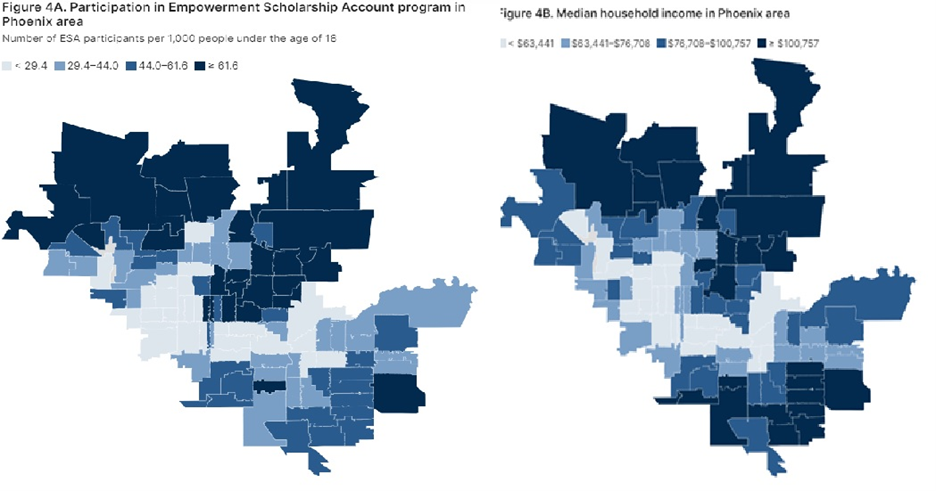
Imagine the major metro area near you if students were free to attend the fanciest school district in the leafiest local suburb. Can Dallas kids enroll in Highland Park? Can Columbus students transfer through open enrollment into Grandview Heights? Will Smith portrayed a kid from a tough background who got to go to school in Bel Air, but how often does this happen in real life? If you mentally put the over/under on the number of students getting the chance to do this at 1, take the under. Thousands of Phoenix students however attend school in Scottsdale. Sadly, a recent report from the Brookings Institution exemplifies the sort of short-sighted thinking that prevents these kinds of opportunities from materializing in other states.
The Brookings Institution recently published a report on the Arizona Empowerment Scholarship Account Program that was long on unsupported claims and short on context. Brookings decided not to engage in nuance in titling its study Arizona’s ‘Universal’ Education Savings Account Has Become a Handout for the Wealthy.
The study can be briefly summarized with two maps from the report: on the left is a ZIP code map of the Phoenix area by the rate of ESA participation (darker=more), and on the right the same zip code map by family income (darker=higher average). The maps look kind of similar. Is Arizona’s ESA program an instrument of plutocracy?

In a word, no. Quite the opposite.
Arizona has four other private choice programs besides the ESA program- all scholarship tax credits. Two of these programs are means-tested for the exclusive use of middle and low-income families. One of the other credits requires scholarship granting organizations to consider income in making awards, and the final credit is for children with disabilities- a fair number of whom will also be from families of modest incomes. These tax-credit programs raised over $264 million for scholarships in 2023, (see below) and higher income families do not qualify for many of these dollars.
Lower-income families desiring to attend private schools often prefer the tuition tax credit program over the ESA program. Meanwhile, higher income families are not eligible for much of the scholarship tax credit funding. Under Arizona law, you cannot participate in both programs.
All the ZIP codes in the Brookings analysis, including those with higher-than-average incomes, have public schools operating in them. The statewide average total district spending per pupil on school is almost twice as high as the ESA program. Higher income Arizonans pay their taxes and are entitled to attend school districts like everyone else, but they are also entitled to participate in the Empowerment Scholarship Account if they desire. If the ESA program is a “give away to the rich” then what pray tell is the Scottsdale Unified School District?
Speaking of Scottsdale Unified, it stands as a shining example of why choice programs should be universal. Scottsdale Unified publishes an ongoing demographic report and publishes the number of out of district open enrollment students served. This graphic is from that report:

The average home price in Scottsdale Arizona stands at $893,000, but 21% of Scottsdale Unified’s enrollment came from out of district through open enrollment. The reason 4,667 students can attend Scottsdale Unified without having a family purchase a $893,000 home is because 9,000 students living in Scottsdale Unified go to school elsewhere- charter schools, other districts through open enrollment, private schools.
Universal choice programs- including the Arizona ESA program but also including charter schools and district open enrollment-help create open enrollment opportunities. A virtuous cycle worked through Arizona schooling as educators supplied high demand school models, nearly all school districts began accepting open enrollment transfers. When a large majority of Phoenix students could attend Scottsdale Unified schools, it had the effect of closing low-demand charter schools.
During the last period in which all six state-level NAEP exams were available, fourth and eighth grade math, reading and science, (2009 to 2015) Arizona students alone made statistically significant gains on all six exams. The Stanford Educational Opportunity Project linked state tests in grades 3-8 across the country for the 2008-2019 period. Arizona’s low-income students have the fastest rate of academic achievement growth in the nation. Counterintuitively, universal choice has worked wonders for low-income students.

The Brookings study is neither the first nor will likely be the last example of folks back east lacking context about Arizona choice. Arizona created two universal choice programs in 1994 (charters and open enrollment) then a mix of universal and means-tested scholarship tax credits and finally the ESA program. Critics predicted doom every step of the way and continue to this day.

A portion of the early adopters of the ESA program, excluded from fully participating in other programs, chose to participate in ESA. Understood in context, you have no reason to feel alarmed and every reason to follow suit in your state- especially if you are concerned about poor students.


